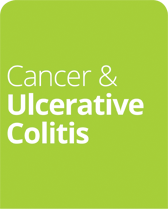Cancer and Ulcerative Colitis
The cause of cancer of the colon is unknown despite extensive and continuing research. It is well documented that there is an increased risk of developing cancer in ulcerative colitis (UC) when compared to the general population, although it is now thought that the risk is much lower than previously believed.Most patients never develop cancer, but its early detection in patients at increased risk can lead to prompt, curative treatment. The increased risk should therefore not cause you great concern as after having UC for around ten years, you will be offered regular screening. Patients with proctitis only need not undergo screening.
The risk of developing cancer is related to two main factors:
- The duration of inflammation, (i.e. the length of time since it was first diagnosed).
- The extent of inflammation (the risk is higher with total colitis).
Duration
Studies have shown that the chance of developing cancer of the colon rises steadily in all patients with the length of time the disease has been present:- after 10 years of total disease (pancolitis) the risk increases to around 4-5%, i.e. out of 100 patients with extensive disease, approximately 4-5 patients may develop cancer.
- after 20 years the risk is around 7 - 8%, i.e. out of 100 patients with extensive disease approximately 7 - 8 patients may develop cancer.
Extent of Disease
75 - 80% of patients with UC who develop cancer of the colon have a history of pancolitis. There is some evidence that a history of left-sided colitis can predispose to cancer but usually this occurs around ten years later than with pancolitis. The risk of cancer in proctitis is no greater than that in the general population.Where does it occur?
The most common site for cancer of the colon in UC to develop is the rectosigmoid area (50%). The second most common is the caecum.What are the signs and symptoms?
These may be variable according to the site and extent of the cancer but generally include:- A change in bowel habit (with or without blood).
- Abdominal pain and flatulence (wind).
- Anorexia (poor appetite).
Late symptoms may include:
- Weight loss
- Fatigue (probably due to anaemia)
- General deterioration in health
How can it be detected?
Colonoscopic surveillance
It is generally recommended that a colonoscopy be carried out at 7 - 10 years following the first signs of disease. If extensive disease is present this should then be performed on a regular basis. An average of 2 - 3 biopsies should be taken per site at approximately 8 sites.Dysplasia is an alteration in the size, shape and organisation of mature cells seen under the microscope. Evidence of dysplasia is generally viewed as a sign of the possibility of future cancer development. Some gastroenterologists believe that it may mean that early cancer is already present.
Dysplasia may be classified as:
- high grade
- low grade
- indefinite
Colonoscopic biopsies showing dysplasia of any grade increase the risk of having a cancer or of developing one in the future. You can generally be reassured that no dysplasia means no cancer.
A positive biopsy for dysplasia is not always diagnostic of cancer but high grade dysplasia is usually considered sufficient evidence to justify removal of the colon.
What happens if signs of cancer are found?
Surgery is usually indicated if the following signs are present:- An obvious cancer is found on colonoscopy.
- The presence of dysplasia of any grade is associated with another lesion or mass. (DALM)
- Dysplasia is found on repeated colonoscopy, or multiple areas of dysplasia are present on any single examination.
- High grade dysplasia on a single examination
What surgery is performed?
There are 2 choices of surgery:- Total colectomy and formation of an ileostomy. The colon is removed, therefore providing a cure of the disease and eliminating any further risk of colonic cancer.
- Formation of an ileo-anal pouch. The rectum is preserved following removal of the mucosal layer. A pouch is formed from loops of small bowel (ileum) and joined to the rectal muscle. As the anal sphincter muscles remain intact, normal bowel control is present. It may be carried out in a single operation or as a two-stage procedure with the formation of a temporary ileostomy allowing the operation site to heal without the continued presence of bowel motions to hinder it.
There are some gastroenterologists who advise prophylactic colectomy (removal of the bowel without presence of dysplasia). A mutual decision can be reached between doctor and patient following discussions in which surgery may be considered preferable to years of uncontrolled colitis, disruption of social and working life and possible repeated hospital admissions either for treatment of severe colitis or for regular surveillance colonoscopy.
New developments are occurring continually in the effort to detect cancer early. These include:
- Flow cytometry
Some centres are able to look at genetic material (DNA) from colonic biopsies but this method is in the very early stages of evaluation in its effectiveness of determining the possible development of cancer. - Immunological studies
Special immunostaining of biopsies may indicate the presence of early cancer changes. - Tumour markers
Examining the blood and stools of patients with long-standing colitis may show evidence of chemicals which reliably predict the presence of cancer. Research is being carried out into the value of these tests as a method of screening alone or in combination with colonoscopy.

